House sales statistics
Data extracted on 4 April 2024
Planned article update: 9 July 2024
Highlights
In the fourth quarter of 2023 when compared with the same quarter of 2022, the number of transacted dwellings decreased in 9 out of the 14 EU Member States covered.
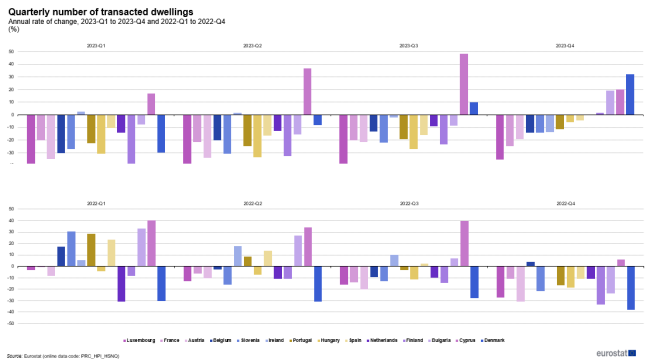
2023-Q1 to Q4 and 2022-Q1 to Q4
(%)
Source: Eurostat (prc_hpi_hsnq)
This article covers changes in the total number and value of dwellings (both newly built and existing dwellings) sold to households. Quarterly and annual figures on the number and value of transacted dwellings are presented for a subset of EU Member States that provided at least 2021 and 2022 data. A breakdown between the number of transacted newly built and existing dwellings is shown (see Figure 3). Annual changes on the total value of transactions are presented together with house prices for the euro area (see Figure 5).
Full article
Quarterly number of transacted dwellings: annual changes
This section covers the 14 EU Member States that provided at least 2022 and 2023 quarterly numbers of transacted dwellings (see Figure 1).
In the fourth quarter of 2023, when compared with the same quarter of 2022, the number of transacted dwellings decreased in 9 countries, with the largest falls observed in Luxembourg (-35.5 %) and France (-24.8 %). It remained stable in the Netherlands and it increased in Denmark (+32.4 %), Cyprus (+20.3 %) Bulgaria (+19.1 %) and Finland (+1.5 %).
In the third quarter of 2023, when compared with the same quarter of 2022, the number of transacted dwellings decreased in 12 countries, with the largest falls observed in Luxembourg (-41.0 %) and Hungary (-27.0 %). It only increased in Cyprus (+48.3 %) and in Denmark (+9.8 %).
In the second quarter of 2023, when compared with the same quarter of 2022, the number of transacted dwellings decreased in 12 countries, with the largest falls observed in Luxembourg (-44.7 %), Austria (-34.1 %) and Hungary (-33.4 %). It only increased in Cyprus (+36.8 %) and Ireland (+1.6 %).
In the first quarter of 2023, when compared with the same quarter of 2022, the number of transacted dwellings decreased in 12 countries, with the largest falls observed in Luxembourg (-50.0 %) and Finland (-41.6 %). As in the second quarter of 2023, it only increased in Cyprus (+17.1 %) and in Ireland (+2.5 %).
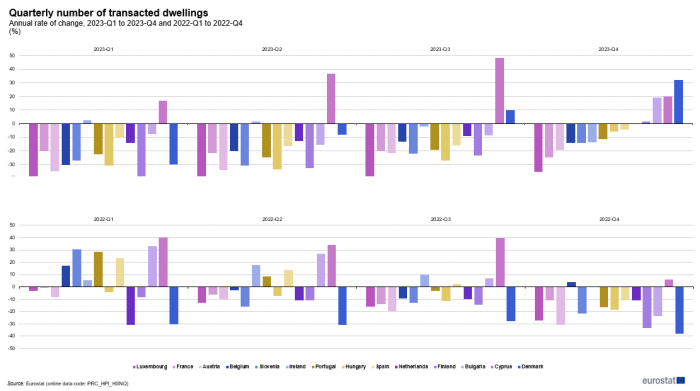
Annual rate of change, 2023-Q1 to Q4 and 2022-Q1 to Q4
(%)
Source: Eurostat (prc_hpi_hsnq)
Annual number of transacted dwellings: changes
This section covers the 16 EU Member States that provided at least numbers of transacted dwellings for the years 2021 to 2022 (see Figure 2).
In 2023, when compared with 2022, for the 14 countries covered, the number of transacted dwellings decreased in 13 countries and increased only in Cyprus (+31.0 %). The largest decreases were observed in Luxembourg (-43.3 %), Austria (-28.2 %) and Hungary (-26.1 %).
In 2022, when compared with 2021, for the 16 countries covered, the number of transacted dwellings decreased in 10 countries and increased in 6 countries. The largest decreases were observed in Denmark (-31.6 %), Austria (-17.6 %), Finland (-16.6 %), the Netherlands (-16.2 %) and Luxembourg (-15.1 %). The highest increases were recorded in Cyprus (+27.4 %), Ireland (+7.7 %) and Spain (+6.0 %).
Luxembourg is the only country that showed a decrease in the number of transacted dwellings every year in the 5 most recent years (2019 to 2023).

Annual average rate of change, 2022 and 2023
(%)
Source: Eurostat (prc_hpi_hsna)
Among the 16 above mentioned EU Member States, 11 provided a breakdown of their transactions by newly built and existing dwellings for 2022 and 2023. In all these countries, the number of transactions for newly built dwellings in 2022 and 2023 was lower than for existing dwellings. This explains why changes in the number of transactions for newly built dwellings had less impact on the changes in the total number of transactions than changes in the number of transactions for existing dwellings (see Figure 3).
In 2023, when compared with 2022, the 11 countries covered recorded a decreasing total number of transactions. Among them, 9 showed a larger decrease for their newly built dwellings than for their existing dwellings. Only in Portugal and Ireland, transactions with existing dwellings decreased more than transactions with newly built dwellings. Overall, for newly built dwellings, the number of transactions decreased in all countries covered and for existing dwellings in 10 out of 11 countries.
For newly built dwellings, the number of transactions decreased the most in Luxembourg(-68.3 %) and decreased the less in Ireland (-1.4 %). For existing dwellings, the number of transactions dropped the most again in Luxembourg (-36.8 %) and only increased in Bulgaria (+0.1 %).
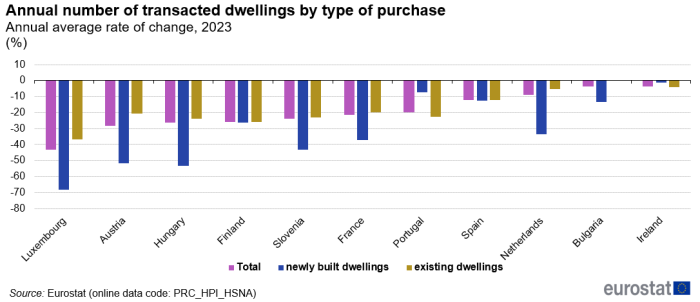
Annual average rate of change, 2023
(%)
Source: Eurostat (prc_hpi_hsna)
This section covers the 15 EU Member Countries that provided at least 2021 and 2022 quarterly numbers of transactions (see Figure 4).
When considering the average quarterly number of transacted dwellings between 2015 and 2023, seasonal patterns could be observed among the countries represented in the graph below. The average number of transacted dwellings was the highest in the fourth quarter in 9 countries (Ireland, Bulgaria, Belgium, Cyprus, the Netherlands, Spain, Luxembourg, Austria and Portugal), in the second or third quarters in 5 countries (Denmark, Hungary, France, Finland and Slovenia) and in the first quarter only in one country (Poland). In 12 of the 15 countries (i.e. all with the exception of Denmark, Hungary and Poland), the first quarter of the year showed the lowest number of transacted dwellings.
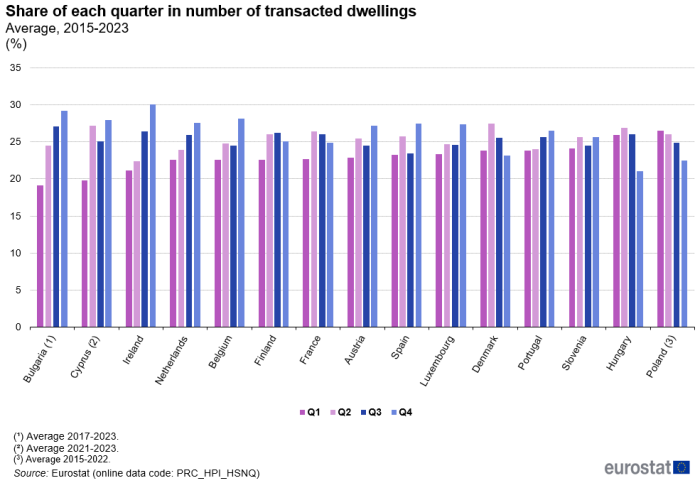
Average, 2015-2023
(%)
Source: Eurostat (prc_hpi_hsnq)
Annual value of transacted dwellings and house prices: changes
The total value of transacted dwellings is equal to the sum of the transaction prices of all dwellings sold in the respective period. As shown in Figure 5, between 2012 and 2017, changes in the total value in the euro area outscored significantly the changes in house prices. This suggests that, in the years when prices decreased (2012-2013), there was a tendency for seeing a contraction in the number of dwellings sold; and when prices increased (2014-2017), the opposite happened. This 'amplification mechanism' seems to have reached its peak in 2012, when prices decreased by -2.1 % and the value of transactions by -14.9 %, and in 2017, when prices increased by +4.4 % and the value of transactions by +15.1 %.
In 2020, during the COVID-19 pandemic, lockdown measures in euro area countries led to a drop in the number of transacted dwellings that explained a decrease in the total value of transacted dwellings despite a continuous increase in house prices.
In 2021, house prices increased very significantly by +7.9 % which is the highest increase for the euro area since 2005 when house prices started to be collected. Changes in the annual value of transacted dwellings were the highest (+25.9 %) since 2011 when the total value of transacted dwellings for the euro area was first estimated. This very high increase suggests a significant recovery in the number of transactions in 2021 following the 2020 pandemic slowdown in market activity.
In 2022, house prices in the euro area increased also significantly by +7.1 % but the total value of transacted dwellings decreased slightly by -0.1 % due to a decreasing number of transactions in many countries (see also Figure 2).
In 2023, house prices decrease by -1.1%. The total value of transacted dwellings will only be known for the next publication date (9 July 2024).
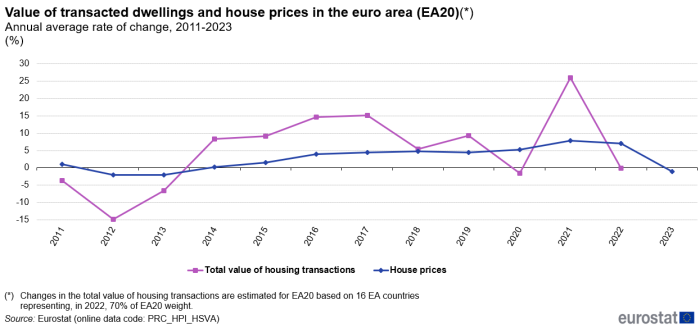
Annual average rate of change, 2011-2023
(%)
Source: Eurostat (prc_hpi_hsva) and (prc_hpi_a)
Source data for tables and graphs
Data sources
House sales statistics are sent by Member States to Eurostat on a voluntary basis. This explains why only a subset of EU Member States send their data to Eurostat.
Depending on the tables, between 15 and 21 EU Member States, as well as the EFTA country Norway, report data. Data for the United Kingdom is only available until 2019.
Annual and quarterly tables reflecting the number and value of transacted dwellings are available:
• Two annual tables (prc_hpi_hsva and prc_hpi_hsna) show an average annual index (2015=100) and an annual average rate of change.
• Two quarterly tables (prc_hpi_hsvq and prc_hpi_hsnq) show a quarterly index (2015=100), a quarterly rate of change, an annual rate of change and a percentage share of the quarter in the year.
Due to missing countries, the EU (EU27) and euro area (EA20) aggregates are not available in the online tables with house sales statistics, but for the purpose of this publication, in Figure 5, the change in the total annual value of transacted dwellings for the euro area has been estimated based on data available from 15 countries representing about 70 % of the euro area weight in 2022 (calculated from the GDP at market prices (based on PPS), price updated with the HPI of the fourth quarter of the countries concerned as available in table prc_hpi_cow).
Figure 5 also shows, for the euro area (EA20), the annual average rate of change of house prices, available in table: prc_hpi_a.
Statistics on house sales and house prices sent by countries cover the same statistical universe: namely the transactions of newly built and existing dwellings (apartments and houses) where the buyer is a household.
Context
In addition to house price statistics, house sales statistics are important to policy makers to have a more complete picture of the residential real estate market.
Direct access to
- House price and sales index (prc_hpi_inx]
- House sales index of number of transactions (2015=100) - annual data (prc_hpi_hsna)
- House sales index of number of transactions (2015=100) - quarterly data (prc_hpi_hsnq)
- House sales index of value of transactions (2015=100) - annual data (prc_hpi_hsva)
- House sales index of value of transactions (2015=100) - quarterly data (prc_hpi_hsvq)
- See national metadata: House price and sales index (ESMS metadata file — prc_hpi_inx_esms)
- House sales statistics are sent by countries to Eurostat on a voluntary basis.